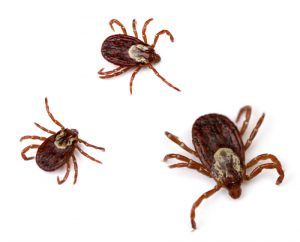The Truth About Ticks
By Chris Williams on June 10, 2011.
1) Ticks are the only 8-legged insects. True or False?
False – Ticks are not insects. They are in the same larger group of arthropods as insects, but they are actually arachnids in the same group as spiders, chiggers, and mites (all 8-legged). The fact that the adult ticks have 8 legs instead of the 6 legs of insects is one clue.
2) The deer tick (also called the blacklegged tick) is found most often in residential areas that have large lots surrounded by woods. True or False?
True – In some areas of the Northeast, it is the most common tick. The adult tick feeds on deer. The larval stage feeds mainly on mice, and the nymphal stage feeds on mice and larger animals like squirrels. All three stages can feed on people and can transmit Lyme disease.
3) Wood ticks are found in standing water in swampy areas. True or False?
False –When they are not on a host animal, ticks can be found in the den of their host animal or in grass, weeds, and shrubbery, especially along animal paths. They climb up on blades of grass where they wait for a suitable animal (or person) to pass by that they can attach to. This behavior is called “questing.”
 4) The deer tick can breed and successfully develop indoors if a female with eggs ends up inside. True or False?
4) The deer tick can breed and successfully develop indoors if a female with eggs ends up inside. True or False?
False – The deer tick cannot successfully reproduce indoors because of the drier air and because its intermediate host animals like rabbits and deer are not available indoors! The only tick that can develop indoors is the brown dog tick which is uncommon in our area. Dogs are its preferred host animal and it can complete its entire life cycle indoors if there is a dog present.
5) Ticks that have not been able to get a blood meal can survive 9 months without feeding. True or False?
True – In fact, some ticks can survive for well over a year without feeding.
6) Applying personal repellents like Deep Woods Off® to an individual’s skin or clothes has absolutely no effect on ticks. True or False?
False – Repellents containing DEET, picaridin, or IR3535 are your best protection against ticks. Wear long sleeves and long pants when in tick areas. Clothing can also be treated with permethrin as a defense against ticks.
7) The deer tick is the only tick in New Hampshire and Massachusetts that can transmit disease to humans. True or False?
False – Unfortunately, we also have the American dog tick which can transmit Rocky Mountain Spotted Fever, Ehrlichiosis, Tularemia, and tick paralysis. The woodchuck tick can transmit Powassan encephalitis. And, the deer tick can transmit Ehrlichiosis, Anaplasmosis, and Babesiosis, as well as Lyme disease. Most of these diseases are uncommon here except for Lyme disease.
8) If you can remove a feeding tick within the first few hours after it has attached, you can avoid transmission of any diseases. True or False?
True – Almost without exception, quick removal of the tick will protect you from disease. Ticks have to feed for several hours to transmit disease (usually at least 6-8 hours for Lyme disease). Checking yourself for ticks after spending time outdoors and removing ticks immediately is very important.